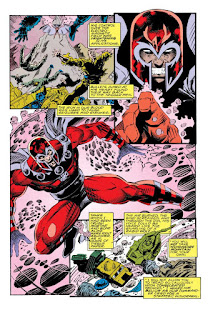Upon receiving a call from his high
school crush, the Atom returns to Hong Kong under the pretense of helping to
protect her from her abusive husband. He soon learns that not everything is as
it seems – especially since her husband is dead and has returned to enact his
vengeance on the person responsible for his death.
The
All-New Atom: Future/Past collects issues 7-11 of The All-New Atom, written by Gail Simone with art by Mike Norton
and Eddy Barrows.
Future/Past
contains two story arcs. The first is a two-part story featuring figurative
ghosts from Ray Palmer’s past returning to haunt his successor, while the
second sees our titular hero facing off against real ghosts as he attempts to come
to terms with his own past. In “The Man Who Swallowed Eternity,” the Atom is
approached by Ryak the Rogue and is threatened into turning over a man he has
yet to meet. As the plot unfolds, we learn that the time stream has been
tampered with due to the activities of a friend of Ray Palmer. It’s a fairly
straightforward science fiction-leaning story that brings our hero into a
possible future, one which gives us a potential glimpse at where the DC Universe
might end up. It’s engaging, but lacks depth and direction. The second arc,
simply titled “Jia,” is really where things get interesting.
Over the course of three issues, writer
Gail Simone teases out an incredible horror-tinged sequence of events that see
the Atom venturing back to China in order to seemingly protect the woman he’s
loved since he was a teenager. Simone rather brilliantly ratchets up the
tension throughout the narrative, keeping readers on their toes by forcing us
to confront and question the honesty of those involved. Jia, Ryan’s high school
crush, is painted as a dejected and emotional wreck of a woman whose husband
was abusive. Her husband, as we learn, once tormented Ryan in school and this
makes matters even more personal. Upon his return to Hong Kong, Ryan learns
that Jia’s husband is dead and is haunting her. Once we learn the reason for
the haunting, things get really intense and it places our hero in a position
where he feels powerless. Simone has never been one to play things safe or
depict characters in a way that is predictable or one-dimensional, which is why
it’s all the more thrilling to see how Jia and her husband are developed
through this arc. It’s one of her most cohesive and compact storylines,
especially since it occurs within a relatively short amount of time. I personally
love when Simone gets dark and twisted, throwing horror at her readers, and she
certainly doesn’t disappoint here.
The art in this collection is flawlessly
executed and sets the tone for both stories. Mike Norton’s pencils are
exuberant and youthful, depicting Ivy Town and its inhabitants in a much more
colourful manner. Norton is more simplistic in his style and this suits the two
part “The Man Who Swallowed Eternity” quite well. By contrast, Eddy Barrows has
a more mature and detailed aesthetic. It’s darker and he excels at creating a
sinister vibe for the book. His action sequences also continue to be superb.
I enjoyed Future/Past significantly more than the collection that preceded
it. Simone hits her stride here. She trims down the supporting cast, utilizing
both Panda and Ryan’s father in a manner that helps to further define Ryan’s
character. She develops our hero’s past and hints at his future while
delivering two engaging storylines, the second of which is massively
entertaining in a twisted kind of way. This is further enhanced by the incredible
work done by Norton and Barrows.
RATING:
B+


















































